Most of the technological challenges faced by farmers can be addressed through partnerships, technology adaptation and through the participation of lead farmers. In this good practice note, Mr Suman S, illustrates how Zero Tillage technology was upscaled among maize farmers in Srikakulam district of Andhra Pradesh using the above mentioned approach.
CONTEXT
Maize is the third most important cereal crop in India, cultivated in over 9 million hectares. It is also the dominant Rabi crop in the Pydibhimavaram cluster of the MITRA (Box 1) program, which is operational in 75 villages, mostly in the Ranasthalam mandal of Srikakulam district, Andhra Pradesh (AP). As with most crops in India, the average productivity of maize is much lower than world average, at just about 30 quintals per hectare while the world average is 58 quintals. The USA produces over 110 quintals per hectare. Even the best state in India, Andhra Pradesh, produces only 52 quintals per hectare.
| Box 1: The MITRA Program:
The MITRA program is Dr Reddy’s Foundation’s (DRF) effort to tackle problems in agriculture extension in India. It is built on the idea that community volunteers can be change agents. MITRA focuses on empowering small and marginal farmers by nudging them to adopt latest technologies and best farming practices. The program bridges the gap in last-mile delivery of agriculture extension services at the grassroots by helping marginal farmers to access existing public extension facilities, engage with agricultural scientists and embrace best farming practices, and more importantly, to impart this to other farmers through physical demonstrations, peer learning and sharing and one-to-one handholding in adoption. The vision is to build a sustainable and scalable community platform to address last-mile delivery challenges, which can be replicated across the country to benefit 100 million small and marginal farmers. MITRA is currently operational in over 500 villages in AP, Telangana, Uttar Pradesh and Bihar, and impacts tens of thousands of farmers through over 1500 lead farmers (community volunteers). |
In 2016, many farmers hadn’t planted the Rabi maize crop for two years due to low rainfall. TheRural Livelihoods team at DRF’s Pydibhimavaram cluster led by Mr. Hari Babu, Area Manager, met with scientists at ICAR-Krishi Vigyan Kendra (KVK), Amadalavalasa (under the Acharya NG Ranga Agricultural University), Srikakulam district to explore solutions to water scarcity, labour shortage and rising production costs.
The Technology Solution
Zero tillage was first suggested by the KVK scientists as a technology with potential to improve farmers’ incomes. The zero tillage or no-till system is a conservation agriculture practice that eliminates tilling and minimizes soil disturbances. This system involves making holes using a simple tool in an untilled field after harvesting paddy and a one-pass planting and fertilizer operation. This method conserves soil and water while requiring no capital investment in machinery for land preparations and intercultural operations. Most importantly, no-tillage can improve maize yields. There is also a water saving of about 18% in this practice, which is about 81,500 litres per hectare.
GOOD PRACTICES
Dissemination on the use of Zero till
Though Zero tillage technology has been demonstrated by KVK-Amadalavalasa, Srikakulam district, in their own demonstration plots in 2010-11, the technology could not reach farmers nearby owing to lack of knowledge on it and absence of fall back support in case farmers face any challenges during implementation. When DRF team was exploring possible technologies which can help farmers in improving soil fertility, water conservation and also increase the yield, the KVK scientists suggested zero tillage as one of the potential solutions. However, they were not confident that farmers would adopt it at scale based on their past experience with the farming community. After discussing the technology with a few progressive farmers and taking their concerns on adopting it, the DRF team prepared outreach material and began to address concerns through a clear plan. With the help of the KVK at Amadalavalasa in 2017, the DRF team then conducted digital video presentations, pamphlet distribution, etc. on zero tillage technology in a few select villages which cultivate maize.
Field testing
Mr. Appalanaidu, a lead farmer from Pathivadapalem village, came forward to try the technology in his field and to motivate his fellow farmers too. In the first year, 34 farmers tried it in small plots totaling about 11 hectares. The result was an average income increase of approximately Rs. 27,000 per hectare.
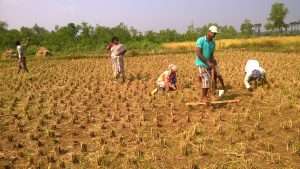 Making holes with wooden peg marker
Making holes with wooden peg marker
Technology Adaptation
At this stage, zero tillage was promoted using a peg marker in which farmers lifted and moved a wooden contraption with spikes to make holes in the field, and dropped seeds into it. Farmers found this tedious even though it was profitable. A better solution was sought from the scientists. An innovation called the Vijaya Marker had been introduced by the DAATTC-KVK, Vizianagaram, which was basically a bicycle handle with axle, bearings and a single wheel that has spikes. On pushing it through the field it made uniformly spaced holes. This was made available to farmers the next year.
Use of Lead Farmers
In 2017, the DRF’s Rural Livelihoods program at Pydibhimavaram (working on the direct implementation model for technology dissemination) transformed into the MITRA program. The MITRA programme focused on amplifying and multiplying the reach of institutional dissemination through farmer-to-farmer extension, and worked with communities to identify community volunteers called lead farmers. Thanks to this new structure and to the Vijaya Marker, which made it easier for technology promotion, the adoption of ZT increased to 286 farmers and 87 hectares.
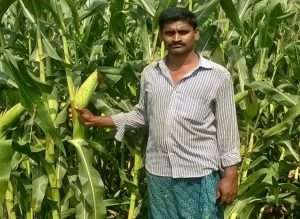 Mr. L. Satyanarayana first demonstrated the zero tillage maize with wheel marker
Mr. L. Satyanarayana first demonstrated the zero tillage maize with wheel marker
Farmer Innovation
Mr. Satyanarayana, a progressive innovator-farmer from Pathivadapalem again took the single wheel marker and worked on the design, trying out different number of wheels. After field testing, he finalized the design for the double wheel marker which made it easier and quicker to implement the technology. Two people can sow an acre of maize in 3-4 hours using this simple device. Since 2017, both the peg marker and the double wheel marker have been available to farmers, and as of 2019, Mr. Satyanarayana has made 23 double wheel markers for his fellow farmers.
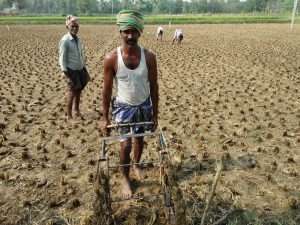 Making holes with double wheel marker
Making holes with double wheel marker
IMPACT
In 2018, adoption of zero tillage tripled to 638 farmers and 266 hectares, and in 2019, it increased to 2226 farmers in over 950 hectares (Table 1). The technology is now mainstream and yields have gone up by a minimum of 15%, from about 85 quintals to up to 100 quintals/ hectare (much higher than the national average and even the world average).
In Rabi 2020, the DRF (Box 2) intends to increase this to over 2000 hectares to reach 50% of the maize area in the region. This is expected to create cumulative additional income of around Rs. 5 crore.
Table 1: Programme Impact
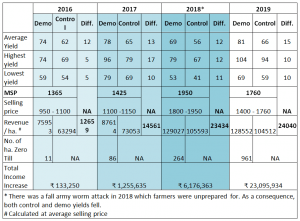
| Box 2:Dr. Reddy’s Foundation (DRF)
DRF is an Indian non-profit, founded in 1996 with the mission to educate and skill young people to fast track them towards livelihood options. DRF’s early programmes focused on child education and skilling. DRF’s Livelihood Advancement Business School, better known as LABS, was an innovative programme way ahead of its time and trained close to 4 lakh youth across 20 states in India. Today, DRF works with diverse partners to collectively solve problems in the areas of livelihood, education, health and climate action. DRF’s livelihoods interventions cover both wage and self-employment based livelihoods in farm and non-farm sectors. Since its inception, DRF impacted 4 lakh children from low income families, 4 lakh underprivileged youth, 1 lakh small & marginal farmers and 10,000 Persons with Disabilities (PwDs) through support to different partner organisations. |
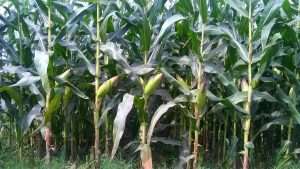 Harvesting stage
Harvesting stage
CHALLENGES
The programmes faced a few challenges in implementation. The first main challenge was to instill confidence in the public extension system in promoting this technology as many were sceptical about it based on their past uninspiring experience. The second major challenge we faced was the lack of local fabricators to experiment with different improvements to the Vijaya Marker. However, we overcame these challenges by partnering with different agencies. The roles of three main actors in this programme are presented in Table 2.
Table 2: Roles played by different actors
| Actors | Roles played |
| Lead Farmers | Early adoption of technology in their fields;
Dissemination of learnings and practices among the fellow farmers based on demo experience; Helping fellow farmers in adopting the technology for the first time. |
| KVK | Training of farmers on zero tillage;
Diagnostic visits during the demo period; On call need based technical advisory for all lead farmers. |
| DRF | Dissemination of technological information to lead farmers through outreach;
Facilitating capacity building and weekly visit for demonstrations to inspire confidence in farmers; Identity creation for lead farmers to disseminate the success story among the fellow farmers. |
LESSONS LEARNT
Ease of doing is the most influential factor compared to the net benefit from the practice for adoption of any new or improved practice among farmers. In this case, the Vijaya Marker implement changed the pace of adoption as it addressed the ease of doing part of the technology/practice.
The results and specific details are always difficult for farmers to articulate and they often share their broad experience. So, as a facilitating agency, we have to put our best efforts in collecting every small detail during and post demonstration from farmers to create data-based evidence.
Community nomination of lead farmers plays a huge role in bringing a sense of ownership in the community to drive farmer-to-farmer extension.
Adopting a problem solving approach by identifying each bottleneck and addressing it with a practical solution can help any practice to scaleup.
END NOTE
We learnt that the following levers can play a key role in addressing the challenges in the agricultural sector.
In the Indian context, the challenges in agriculture are directly related to small & marginal farmers as they constitute more than 85% of total farmers in the country. Any product/ service/ innovation needs to address the needs of small & marginal farmers for it to be adopted at scale. And unfortunately, be it farm mechanisation, agricultural credit or any post-harvest product, they are not affordable or designed for this group. Therefore, innovation in products/services in this space can contribute to the sector in a big way.
Agriculture extension needs to be seen as a value addition rather than a pro-poor activity and digital technology with minimum human intervention can help achieve this transformation. Sustainable last-mile delivery at a community level needs to be nurtured. It can help innovations reach farmers at scale and become mainstream. Farmers’ collectives are one alternative but we also need to invest in other possible alternatives.

Suman S is Senior Manager, Rural Livelihoods, Dr Reddy’s Foundation, Hyderabad (suman@drreddysfoundation.org)

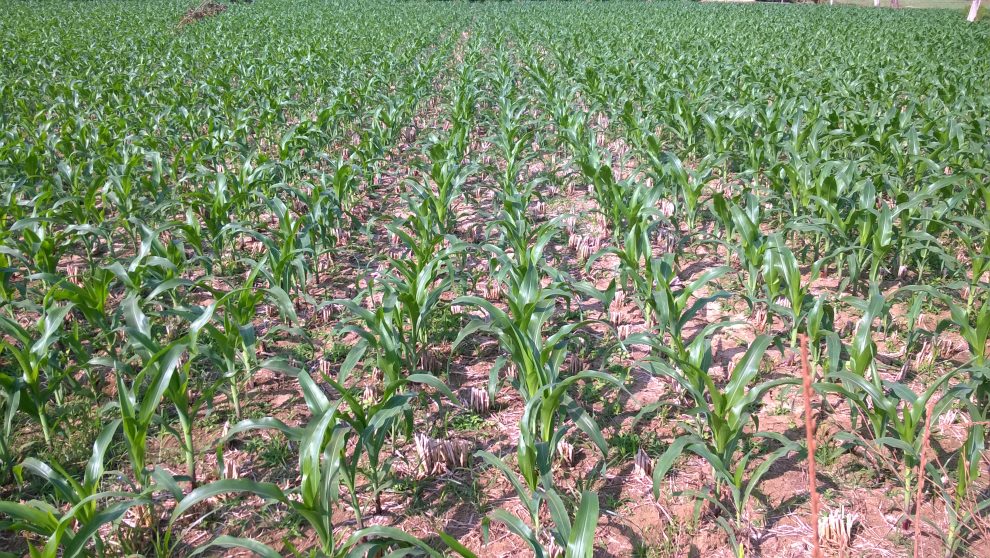
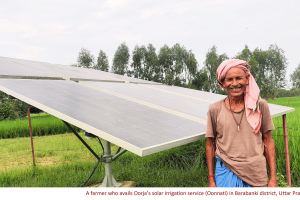
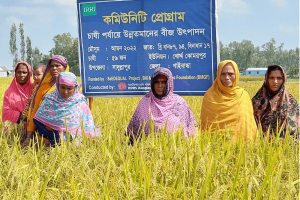
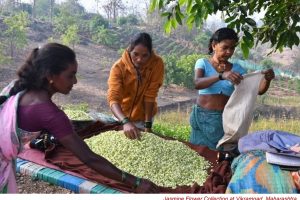
The efforts of Dr. Reddys Foundation in promoting maize cultivation among small and marginal farmers especially in Srikakulam district, one of the backward districts of AP is highly commendable. This reminds me of the famous book of Fukuoka “The one straw revolution: An introduction to natural farming”.
DRF played a crucial role in coordinating with the scientists of KVK and progressive farmers in increasing the adoption of zero tillage and in modifying the wheel marker to make the process easy to the farmers. In addition, the foundation maintained its constant touch with the farming community.
When the yields of maize have gone up whether the farmers faced any problem in its marketing?
Congratulations to the team of DRF and Mr. Suman on coming out with a useful practice of maize cultivation which I hope could be replicated in similar agro-climatic areas. Thanks to AESA for publishing this good practice.